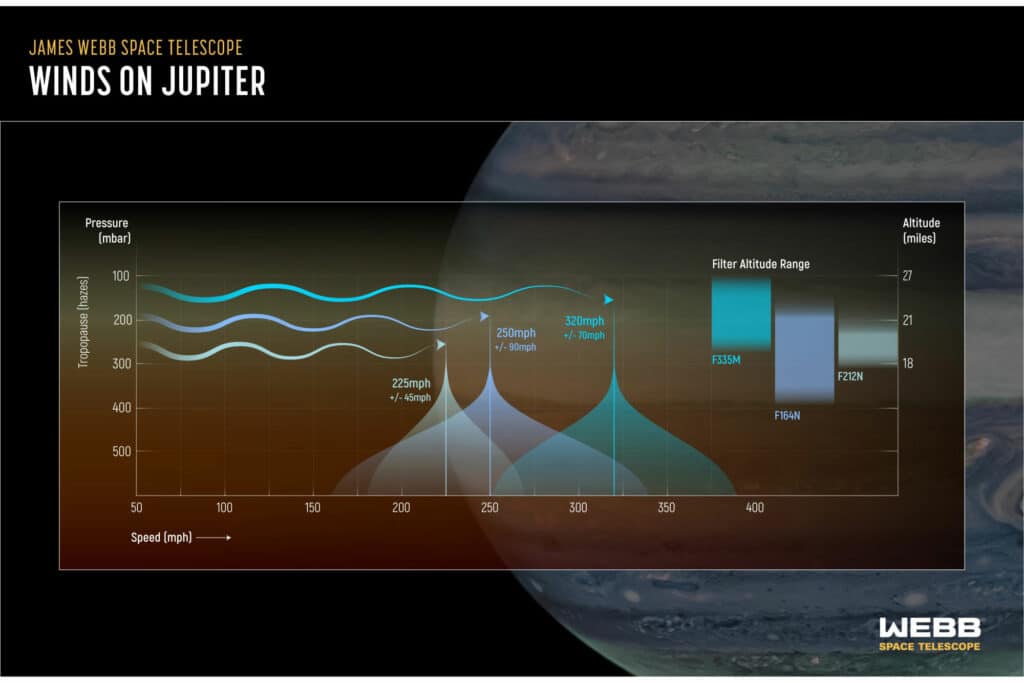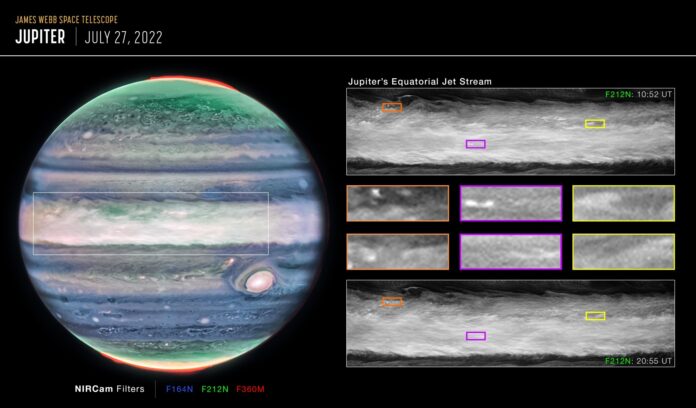The James Webb Space Telescope has uncovered an entirely new, previously unseen feature in Jupiter’s atmosphere. The high-speed jet stream spans over 3,000 miles (4,800 kilometers) wide and sits over Jupiter’s equator above the main cloud decks.
Cloud motions at tropospheric levels can be used to trace the east-west zonal jets that alternate in Jupiter’s atmosphere according to latitude. Hazes obscure the equatorial atmosphere at elevations where thermal infrared observations that define the stratosphere dynamics lose some sensitivity above and below the cold tropopause at 100 mbar.
James Webb Space Telescope observations of Jupiter in July 2022 show these hazes in greater detail than ever. The observations reveal the presence of an intense equatorial jet at 100–200 mbar. Understanding how the layers of Jupiter’s infamously turbulent atmosphere interact with one another and how Webb is uniquely able to track those features is made possible by the finding of this jet.
Ricardo Hueso of the University of the Basque Country in Bilbao, Spain, lead author of the paper describing the findings, said, “This is something that surprised us. What we have always seen as blurred hazes in Jupiter’s atmosphere now appear as crisp features that we can track along with the planet’s fast rotation.”

On the other hand, Webb’s look farther into the near-infrared than before is sensitive to the higher-altitude layers of the atmosphere, around 15-30 miles (25-50 kilometers) above Jupiter’s cloud tops. In near-infrared imaging, high-altitude hazes typically appear blurry, with enhanced brightness over the equatorial region. With Webb, finer details are resolved within the bright, hazy band.
The newly discovered jet stream travels about 320 miles per hour (515 kilometers per hour), twice the sustained winds of a Category 5 hurricane here on Earth. It is located around 25 miles (40 kilometers) above the clouds in Jupiter’s lower stratosphere.
The team determined how quickly the winds vary with altitude and produce wind shears by comparing the currents detected by Webb at high altitudes to those observed by Hubble at deeper layers.
Thanks to Webb’s exquisite resolution and wavelength, its coverage allowed for the detection of small cloud features used to track the jet; the complementary observations from Hubble taken one day after the Webb observations were also crucial to determine the base state of Jupiter’s equatorial atmosphere and observe the development of convective storms in Jupiter’s equator not connected to the jet.
Team member Michael Wong of the University of California, Berkeley said, “We knew the different wavelengths of Webb and Hubble would reveal the three-dimensional structure of storm clouds, but we were also able to use the timing of the data to see how rapidly storms develop.”
Scientists are now looking forward to additional observations of Jupiter with Webb to determine if the jet’s speed and altitude change over time.
Team member Leigh Fletcher of the University of Leicester in the United Kingdom said, “Jupiter has a complicated but repeatable pattern of winds and temperatures in its equatorial stratosphere, high above the winds in the clouds and hazes measured at these wavelengths. If the strength of this new jet is connected to this oscillating stratospheric pattern, we might expect the jet to vary considerably over the next 2 to 4 years – it’ll be really exciting to test this theory in the years to come.”
“It’s amazing to me that, after years of tracking Jupiter’s clouds and winds from numerous observatories, we still have more to learn about Jupiter, and features like this jet can remain hidden from view until these new NIRCam images were taken in 2022.”
Journal Reference:
- Hueso, R., Sánchez-Lavega, A., Fouchet, T. et al. An intense narrow equatorial jet in Jupiter’s lower stratosphere observed by JWST. Nat Astron (2023). DOI: 10.1038/s41550-023-02099-2
